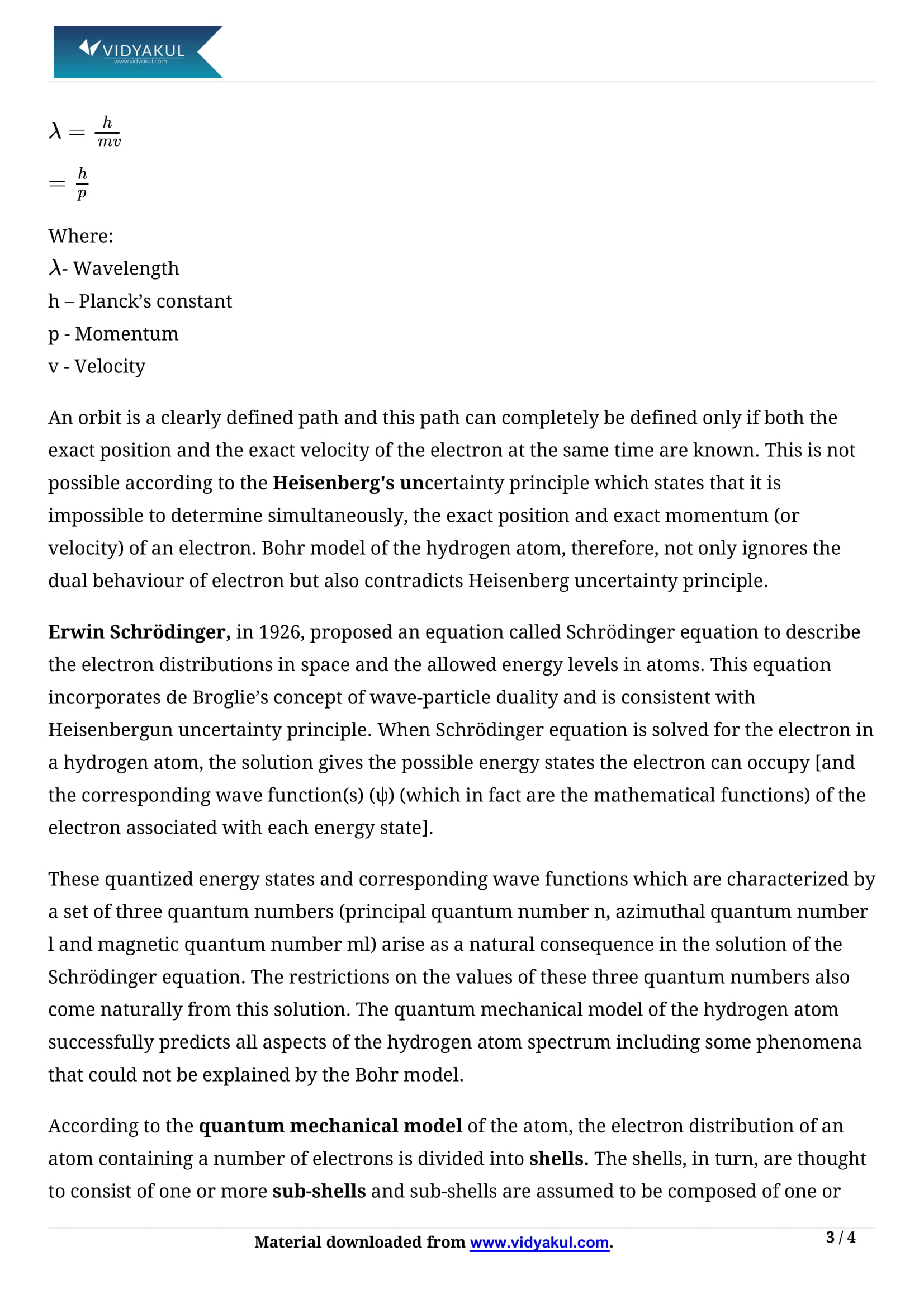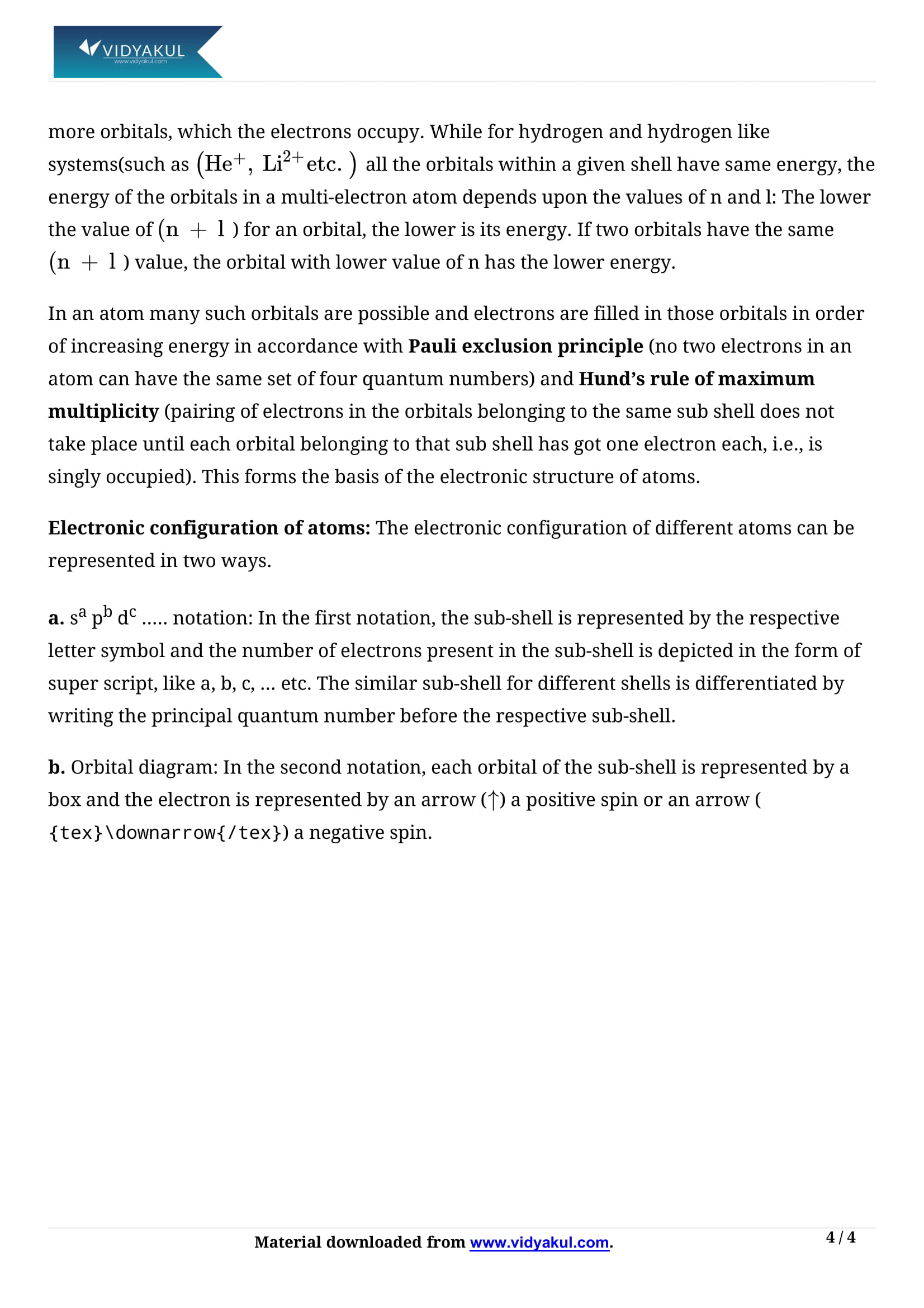Structure of Atom Class 11 Notes

Chapter 2 Structure of Atom
The Atom structure is an important chapter for students preparing for their 11th grade exams. These NCERT notes are designed according to the latest CBSE guidelines and provide students with comprehensive answers to all questions in the NCERT Class 11 Chemistry Textbook. It helps students achieve good grades not only in Year 11 GCSE but also in competitive exams such as JEE Main, BITSAT, NEET and more. Students can download and use the NCERT notes for Class 11 Chemistry Chapter 2 PDF file from this article. Study or revise test topics.
CBSE 11th CHEMISTRY CH-2
Points to Remember
We have provided a few important points that are covered in NCERT Class 12 Maths Chapter 7 Integrals to help students in their exam preparations. Refer to the points below:
Atom is made up of electrons, protons and neutrons called fundamental particles.
Electron was discovered by J. J. Thomson from study of cathode rays.
Mass of electron = 9.11 × 10−31 kg = 1/1837 th of that of H-atom.
Charge on electron = 1.602 × 10−19 coulomb.
e/me = 1.758820 × 1011 C Kg−1
Proton was discovered by Goldstein from study of anode rays using a perforated cathode in the discharge tube.
Neutron was discovered by Chadwick by bombarding Be or B atoms with α-rays.
Atomic number (Z) = number of protons in the nucleus of an atom = number of electrons in a neutral atom
Mass number (A) = number of protons (Z) + number of neutrons (n)
Atoms of the same element having the same atomic number but different mass numbers are called isotopes.
Atoms of different elements having different atomic numbers but same mass number are called isobars.
Students can get all the important points for NCERT Class 11 Chemistry Chapter 2 Structure of Atom for free by visiting Vidyakul.
Topics and Sub- Topics
The second chapter of NCERT Class 11 Chemistry, Structure of the Atom, covers atomic and molecular masses as well as mole concepts, chemical reactions, and molecular formulas. Students also learn about Dalton's atomic theory. In this chapter, students will address many practical questions based on concepts. This will help students better understand the concept. At GCSE, students can anticipate at least one question from this “Low Cost High Return” chapter.
Students can refer to the table below to check the important topics covered in NCERT 11th Chemistry Chapter 2:
Frequently Asked Questions
What does the ‘Heisenberg uncertainty principle’ state?
The Heisenberg Uncertainty Principle states that the simultaneous determination of the velocity and position of a particle is impossible.
Who was Rutherford?
Ernest Rutherford was a New Zealand physicist who came to be known as the father of nuclear physics.
What is wavelength?
The distance between corresponding points of two consecutive waves is known as wavelenght. It is usually denoted by the Greek letter lambda.
Practice Questions
1. Calculate the wavenumber and frequency for the below:
Yellow light emitted from a sodium lamp has a wavelength (λ) of 580 nm
2. Calculate and provide the number of electrons for the following:
H+2
O+2
H2
3. Calculate the wavelength using the following details:
Mass of electron is 9.1 × 10–31 kg and K.E. is 3.0 × 10–25 J
Atom is made up of electrons, protons and neutrons called fundamental particles.
Electron was discovered by J. J. Thomson from study of cathode rays.
Mass of electron = 9.11 × 10−31 kg = 1/1837 th of that of H-atom.
Charge on electron = 1.602 × 10−19 coulomb.
e/me = 1.758820 × 1011 C Kg−1
Proton was discovered by Goldstein from study of anode rays using a perforated cathode in the discharge tube.
Neutron was discovered by Chadwick by bombarding Be or B atoms with α-rays.
Atomic number (Z) = number of protons in the nucleus of an atom = number of electrons in a neutral atom
Mass number (A) = number of protons (Z) + number of neutrons (n)
Atoms of the same element having the same atomic number but different mass numbers are called isotopes.
Atoms of different elements having different atomic numbers but same mass number are called isobars.
What does the ‘Heisenberg uncertainty principle’ state?
Who was Rutherford?
What is wavelength?
H+2
O+2
H2
Know more about this in Structure of Atom Class 11 Notes pdf.
Download this solution for FREE Download this PDF
Download Vidyakul App for more videos, PDF's and Free video lectures.







